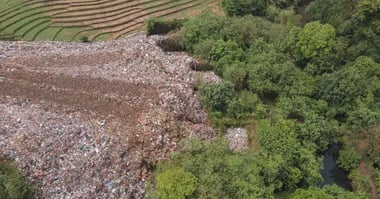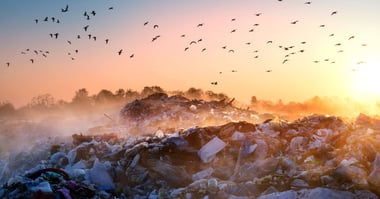
Tamara Davison
Tamara Davison is a journalist who specializes in sustainability and the environment. Reporting from around the world, she's seen firsthand the direct impact waste is having on coastal communities and our oceans. As a diver trained in ecological monitoring, the changes Tamara has seen in marine habitats inspired her to action. She's previously written for The Guardian, The Independent and the Evening Standard. She's also produced environmental documentaries for EuroNews.
Humans produce more than 400 million tons of plastic waste every single year, according to the United Nations Environment Program (UNEP).
Not only is this crisis escalating, it’s also disproportionately impacting people in developing countries.
A report presented by David Attenborough in 2019 said up to 1 million people in low-income countries die from issues linked to waste management every year.
The global south shoulders most of the burden due to poor waste management infrastructure, funding, and education, but the reality is more complex — developed nations play a significant role, too.
The impact of plastic pollution goes far beyond borders, but here are the nations bearing the brunt.
What’s on this page?
01 | The most polluted countries in the world02 | Which countries consume the most plastic?
03 | What’s the solution?
04 | Methodology
05 | Summary
The most polluted countries in the world
|
Country |
Annual amount of plastic pollution emitted into the environment (in tons) |
|
India |
9.3 million |
|
Nigeria |
3.5 million |
|
Indonesia |
3.2 million |
|
China |
2.8 million |
|
Pakistan |
2.6 million |
|
Bangladesh |
1.7 million |
|
Russia |
1.7 million |
|
Brazil |
1.4 million |
|
Thailand |
1 million |
Source: Nature - A Local-to-Global Emissions Inventory of Macroplastic Pollution, 2024
1. India
Amount of annual plastic pollution: 9.3 million tons
India generates more than 9.3 million tons of plastic pollution each year, accounting for over one-fifth of global plastic emissions. Only around 8% of this is recycled, meaning the majority will be burned, sent to landfills, or dumped in natural landscapes.
India's socioeconomic makeup adds to this challenge. Around 60% of the population live on less than $3.10 (€2.81) a day, and there is a connection between poverty and plastic pollution.
It’s not always the case, but low-income populations tend to bear the brunt of environmental injustice, living closer to landfills and polluted areas and not having as much access to waste management. Money is also key in the fight against plastic pollution as it unlocks more access to environmentally friendly products, good recycling systems, and education.
More than half of the country also lives in rural areas, where it’s common to burn waste instead of sending it to landfill. Uncontrolled landfills reportedly outnumber sanitary and controlled waste disposal sites by 10:1, so official figures are hard to verify.
The people of India also speak more than 100 major languages, so even communicating environmental efforts may take a lot of work.
Authorities are making some efforts to address the country’s plastic crisis. The government implemented a single-use plastic ban in 2022 that ordered a ban on producing, importing, and selling 19 items, including plastic straws and earbuds. But this didn’t apply to all single-use materials, and policing is nearly impossible.
2. Nigeria
Amount of annual plastic pollution: 3.5 million tons
The West African nation of Nigeria, home to 200 million people, is the second-largest plastic emission hotspot in the world.
According to Nature, Nigeria creates more than 3.5 million tons of plastic pollution each year, a considerable increase from previous studies.
The Global Plastic Action Partnership said Nigeria fails to recycle around 88% of plastic waste. Another report claimed that the nation released 200,000 tons of plastic waste into the ocean in 2018.
While at least 57 recycling organizations manage household waste for local councils around the capital of Lagos, mismanagement and incineration of plastic waste are common in Africa’s most populous country.
Alarmingly, up to 60 million water sachets are discarded onto the streets of Lagos every day.
Greenpeace called Nigeria a “hotbed of plastic pollution,” attributing issues to the country's size and scale. The report adds that more than 41,000 Nigerians died from cancer-related illnesses in 2018, and the open burning of plastic waste may be contributing to this.
Nigerian authorities are finally starting to act, but progress is slow. In early 2025, they plan to introduce a ban on single-use plastics nationwide. Several private organizations and entrepreneurs are setting up recycling and enhanced waste management projects.
3. Indonesia
Amount of annual plastic pollution: 3.2 million tons
Indonesia, the world’s fourth-most populated country, produces around 3.2 million tons of plastic trash every year.
The country has thousands of islands, so preventing waste from entering its rivers and flowing into the ocean is a huge challenge.
These issues are even worse during the rainy season, which is also becoming more severe due to climate change, washing even more trash into water systems. According to the SEA Circular Project, Indonesia is the second largest global contributor to ocean-bound litter.
Given that Indonesia’s economy hinges predominantly on fishing and tourism, keeping the country’s oceans clean and healthy is critical.
However, things like overtourism on the island of Bali, one of Indonesia’s most famous regions, also contribute to the plastic waste problem. It’s resulted in massive fires at the local dump and concern about waste overspilling into the natural surroundings.
The archipelago cannot maintain its waste management compared to its growing population. To counter this, authorities have introduced plans to ban single-use plastic by 2029 and mandates for manufacturers to reduce plastic packaging by 30%.
Many grass-roots organizations, including Sungai Watch and Joseph Recycling, are also trying to take the lead. Both try to leverage ocean and river cleanups, alongside education programs to inspire more action.
4. China
Amount of annual plastic pollution: 2.8 million tons
China was previously named the world’s biggest plastic polluter, but things are starting to change. The nation is still the world’s largest producer of single-use plastic but is taking steps to address its pollution levels.
China currently contributes 2.8 million tons of plastic pollution each year, but the Nature report points to some efforts to increase waste management.
Earth.Org claims that China recycles around 17% of its plastic waste, but this statistic isn’t equal across the country. For example, Shanghai introduced mandatory waste sorting in 2019, increasing recycling activities and decreasing the amount of waste incinerated.
In 2017, China banned the import of global waste from other countries, including plastics, paper, and other recyclables. This forced other developed countries to reconsider their own relationship with waste. Several years later, China launched a five-year action plan to phase out plastic waste across the country.
In 2022, China banned single-use plastic bags and implemented rules for restaurants to reduce single-use plastic items by 25%.
5. Pakistan
Amount of annual plastic pollution: 2.6 million tons
Pakistan has the world’s fifth-largest population and is the fifth-largest producer of plastic waste. The latest statistics attribute 2.6 million tons of plastic pollution to the South Asian country, which borders India.
Pakistan's most significant environmental challenge is its lack of waste management systems.
Up to 50% of waste dumped in landfills in Pakistan is left to informal waste pickers to sort and recycle. This is dangerous, poorly paid work that offers no workplace protections, despite being a crucial step in the nation’s recycling efforts.
On top of that, Pakistan also imports up to 80,000 tons of hazardous waste each year from other parts of the world. The WWF reported that a large portion of Pakistan’s waste ends up in the ocean: 65% of plastic found on Pakistan’s beaches is plastic water bottles, bottle caps, bags, and packaging.
The number of provinces banning single-use plastic in Pakistan is growing, but there hasn’t been a national mandate so far. Authorities have also proposed plans to create ‘zero-plastic waste’ cities, but addressing the volume of plastic waste impacting Pakistan will take time.
6. Bangladesh
Amount of annual plastic pollution: 1.7 million tons
According to the latest study, Bangladesh produces 1.7 million tons of plastic pollution every year.
Bangladesh has undergone rapid urbanization in recent decades, but its waste management infrastructures have failed to keep up. Local authorities are increasing efforts to address the challenge.
Research claims that 646 metric tons of plastic waste are collected every day in Bangladesh to counter the plastic crisis. This pales in comparison to the annual output, but it signals a growing awareness of the issue.
What’s even more ambitious is the country’s future goals: Bangladesh wants to recycle 50% of its plastic waste by 2025.
A blog from the World Bank claims that microenterprises in the country may play a key role in creating innovative solutions, and taking the plastic crisis into their own hands.
.jpg?width=1200&height=630&name=landfill%20(1).jpg)
7. Russia
Amount of annual plastic pollution: 1.7 million tons
Russia is a high-income country, seemingly bucking the trend of developing nations on this list. It produces more than 1.7 million tons of plastic pollution each year.
This is contributing to concerning levels of plastic pollution across the sprawling nation. Russia’s Lake Baikal is contaminated with high levels of microplastics, and experts have identified a lot of plastic waste in the Russian Arctic.
A number of factors influence Russia's plastic levels, but there's not a lot of data regarding this. A World Bank report about waste in Russia points to "deteriorating waste collection and disposal infrastructure," and other factors such as the cost associated with municipal recycling.
Officials signaled plans in 2021 to ban non-recyclable plastic across Russia, but the ban wasn’t implemented. Now embroiled in an ongoing war, environmental efforts are likely to have been sidelined by the conflict.
In 2024, the country’s largest plastic recycling plant was opened near Moscow. However, it reportedly ramped up plastic production by as much as 11.3% across several months in 2023.
8. Brazil
Amount of annual plastic pollution: 1.4 million tons
Brazil is the only South American nation on this list, producing more than 1.4 million tons of plastic pollution every year.
Interestingly, Brazil has a bigger population than Bangladesh and Russia but produces less plastic waste than them. However, it recycles just 4% of its plastic waste — considerably lower than the global average.
According to Recycling Today, Brazil has over 3,000 open landfills, while 26% of Brazilian cities have no recycling infrastructure at all. Lack of federal support and funding is partially behind this.
The country has introduced several policies aimed at combating waste and supporting the environment in recent years — but there’s still some way to go. Brazil has been a global leader in recognizing the work of its 281,000 informal waste pickers and the work they do in the country’s recycling systems.
9. Thailand
Amount of annual plastic pollution: 1 million tons
The Southeast Asian nation of Thailand produces around 1 million tons of plastic pollution every year.
Unlike other nations on this list, Thailand doesn’t have one of the world’s biggest populations, but it is the sixth-biggest contributor to ocean plastic waste.
According to SEA Circular, the country’s economic growth is exasperating the challenges of plastic waste.
While the country's booming tourism industry and expanding economy are helping to lift millions out of poverty, these gains also drive a surge in plastic consumption and waste production.
To tackle its waste problem, Thailand is banning all plastic waste imports by 2025, and there have also been talks about banning or limiting plastic bags and other single-use plastics.
Which country consumes the most plastic?
Here’s where things get interesting.
Although this article spotlights the countries adding to the most plastic pollution, these countries don’t necessarily consume the most plastic.
When this waste is mismanaged, that’s when it becomes environmental pollution.
According to the 2023 Plastic Overshoot report, the countries consuming the most plastic per capita include Iceland, Mongolia, United Arab Emirates, Singapore, Luxemburg, Kuwait, the United States, Italy, Saudi Arabia, and Canada.
As you can see, none of the countries we've listed that are suffering from plastic pollution are on this list. This means that some countries are better at managing their plastic waste or exporting it to other regions that have to deal with the consequences.
What’s the solution?
The solution to plastic pollution doesn’t have to be that complicated. However, it requires global cooperation, communication, and support.
The first step is turning off the tap on virgin plastic manufacturing. There is enough plastic to go around — despite what the oil companies and petrochemical giants may have you think.
Then, we need to create a circular economy that goes beyond plastic neutrality. One where waste is managed effectively within national borders but with international cooperation to ensure sustainable practices worldwide.
Methodology
We've based this article on the findings of a recent study on plastic pollution levels around the world. The report combines information from various data sets to draw conclusions about which countries contribute to the most pollution (mismanagement of plastic).
However, it's worth noting that there is inconsistent data about unofficial dumps and illegal waste management, meaning we’ll never truly know how much plastic pollution impacts the world.
Even countries that do monitor their waste levels may not necessarily be able to record exact data about plastic levels. It’s no secret that global recycling efforts are woefully lagging compared to the pace of plastic output.
Summary
Plastic pollution is impacted by a complex web of factors: money, weather, conflict, education, government policies, and more.
It can seem like an endless battle that nations like India, Nigeria, and Indonesia are paying the ultimate price for.
From educating communities about the negative impact of plastic to supporting the development of alternative packaging materials, there are many ways we can do our bit to clean up the future.
Plastic pollution is a global issue that requires an international response from governments, businesses, and individuals. What’s clear is that we need to act now.

%20(1).webp)
%20(1).webp?width=380&name=Pile-of-plastic%20(1)%20(1).webp)
.webp?width=380&name=Plastic-pollution-surface-of-water%20(1).webp)
.webp?width=380&name=Colourful%20corals%20(1).webp)

.webp?width=380&name=solar-collection%20(1).webp)


.webp?width=380&name=River%20waste%20(1).webp)
.webp?width=380&name=Paper-packaging%20(1).webp)
.webp?width=380&name=recycling%20(1).webp)
